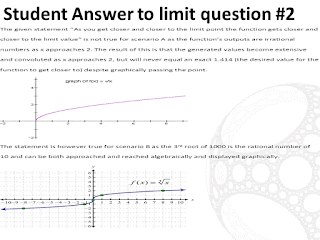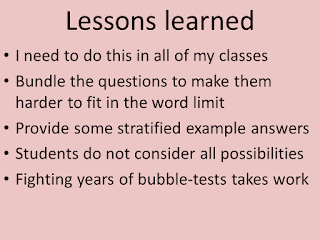If you have never seen an IGNITE talk, each presenter gets 20 powerpoint slides, that autoadvance every 15 seconds. GO! They are fun, fast, and usually pretty good. My talk this year was on Student Understanding of Graphs. The slides are below. In the talk I mention a linear concepts exam that I have been giving my students, and how amazed I was at the lack of understanding my Calculus I students showed with graphs, equations, and their relationships. You can see some of the questions and the percentage of my students who got the question correct below. To clarify, historically I have given the exam during the first week of the semester. But this semester I tried something different, and gave it after 6 weeks of the semester. So we had already discussed graphs of functions, and even the idea of increasing and decreasing functions.
In the IGNITE talk, I mentioned several things, so let me lay them out here. First, a few sites about student (and people in general) and how they learn and remember things.
1) A good blog post from Oxford University Press about memory and effort
2) An MIT paper about making visualizations memorable.
3) Here is a good summary of #2 above H/T Maria Anderson
4) Brain Rules Website
I also threw out in the talk the idea that Learning Styles is not really true. At least, the idea the each of us has our own style of learning that works best for us. Below are some of the links related to that idea:
1) A short intro about why it is over rated
2) A little longer FAQ about learning styles and why they are over rated, at best.
3) A good read about some of the research debunking the idea of learning styles.
4) Last, a really nice page at the University of Texas debunking the idea.
** Slides will be below here in about a week after the talk **
NOTICE, Google currently owns blogger, and as such, uses cookies to collect information, potentially a lot of it. You have been warned.
Pages - Fast Find.
Tuesday, November 15, 2016
AMATYC 2016 - Denver - Memo Talk
This is the post that goes with my talk at AMATYC about having your Calculus Students write memos. The slide deck is below, but you can also get a good sense of the talk here. I pair up my students, then have them write 5-6 one page memos during the semester. You can see the ground rules, form they have to put the memo in, and examples of the memo questions for Calculus I here.
The rules and examples for Calculus II are here. For both classes, the idea of writing to communicate, with a hard word limit, is new, and also a little rough at first. However, since I also do projects, I have found that starting with memos works well, as it gives me and the students a chance to set expectations for their writing before they start working on the big projects.
In my opinion, this has gone really well. So well in fact, that I will be expanding on the memos in the upcoming semesters. Watch this space as I try to blog about how well it will go this spring in my Calculus II classes.
Thanks.
(Slides will be posted in about a week after the conference!)
The rules and examples for Calculus II are here. For both classes, the idea of writing to communicate, with a hard word limit, is new, and also a little rough at first. However, since I also do projects, I have found that starting with memos works well, as it gives me and the students a chance to set expectations for their writing before they start working on the big projects.
In my opinion, this has gone really well. So well in fact, that I will be expanding on the memos in the upcoming semesters. Watch this space as I try to blog about how well it will go this spring in my Calculus II classes.
Thanks.
(Slides will be posted in about a week after the conference!)
Monday, January 4, 2016
Joint Math 2016 talk on alternative assessment
This Thursday afternoon, 1:40 - 1:55 in Room 608, session 1116-A5-1038, I will be presenting on the idea of having students write memos as an assessment. It was something I did this past fall with my Calculus I students.
The basic idea was to have my students form groups and then as a group write a memo under some rules to answer a more conceptual question. The rules were the students could use as many pictures as they wanted, but at most 200 words to answer the question. It was an interesting activity. I learned several things about my students. One of the biggest that I learned was that they really do not understand the density of the real numbers, and what what a continuous function really is. That has changed some things that I will do for the next time I teach Calculus I.
The presentation slides are below, as are the copies of the six different memo question sets that I
used during the semester. I plan on doing memo questions this semester in Calculus II. Hence I plan on doing a few posts this coming spring over how that is going with my two sections.
Memo Question set 1
Memo Question set 2
Memo Question set 3
Memo Question set 4
Memo Question set 5
Memo Question set 6
The slides are here:
The basic idea was to have my students form groups and then as a group write a memo under some rules to answer a more conceptual question. The rules were the students could use as many pictures as they wanted, but at most 200 words to answer the question. It was an interesting activity. I learned several things about my students. One of the biggest that I learned was that they really do not understand the density of the real numbers, and what what a continuous function really is. That has changed some things that I will do for the next time I teach Calculus I.
The presentation slides are below, as are the copies of the six different memo question sets that I
used during the semester. I plan on doing memo questions this semester in Calculus II. Hence I plan on doing a few posts this coming spring over how that is going with my two sections.
Memo Question set 1
Memo Question set 2
Memo Question set 3
Memo Question set 4
Memo Question set 5
Memo Question set 6
The slides are here:
Subscribe to:
Posts (Atom)














